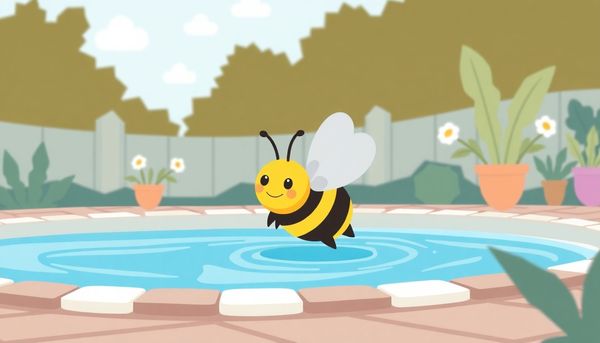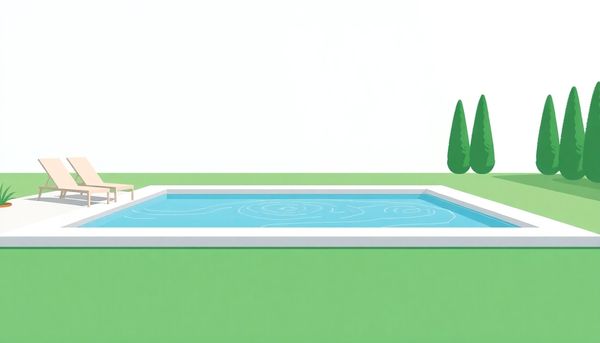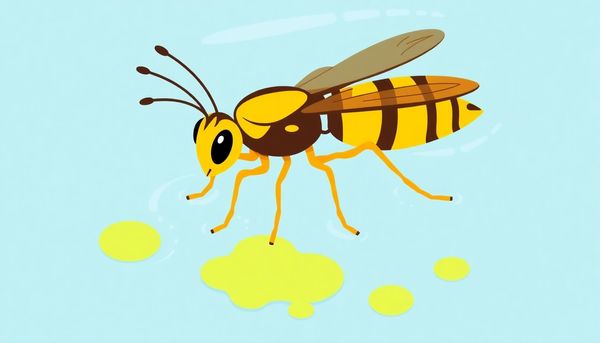How to Keep Your Pool Bug-Free: Effective Strategies for Summer
November 21th, 2024
November 21th, 2024
On a warm summer afternoon, few things are more inviting than a sparkling pool ready for a refreshing swim. The water shimmers under the sun, promising a perfect escape from the heat. But then, an unexpected visitor decides to join the party — the notorious water bug. If you've ever hosted one of these uninvited guests, you know the scene: a bug gliding serenely across the surface, seemingly taunting you with its unwelcome presence.
Water bugs, including species like backswimmers and water boatmen, can quickly turn an idyllic pool day into a frustrating battle. These pests aren't just a nuisance; they can bite, causing irritation and discomfort. Their presence often indicates a larger issue: an ecosystem imbalance, perhaps fueled by algae or organic debris. As I discovered a few summers ago, a surprise infestation can be both puzzling and persistent. After days of futile skimming, I realized a more strategic approach was necessary.
Understanding the root cause of the invasion is critical. It's essential to address what attracts these bugs in the first place. Whether it’s about maintaining proper chemical balance or adopting preventive measures, tackling the problem requires a combination of tactics. By learning how to effectively manage and eliminate these critters, you can reclaim your pool as a place of relaxation and enjoyment. With the right strategies, those pesky water bugs will soon be a thing of the past, ensuring your pool remains a sanctuary of tranquility.

There's an unspoken pact between pool owners and nature: your swimming spot should be free from uninvited critters. But when water bugs crash the party, swift action is necessary. First up, grab a trusty pool skimmer. This tool is your frontline defense, perfect for scooping water bugs before they make a quick getaway. Aim for a skimmer with a deep, durable net—imagine wielding a butterfly net but for aquatic interlopers.
Next, it's time for some pool vacuuming. Manual vacuums come in handy for this task, allowing you to methodically remove debris and sediment. This step is crucial, as it prevents cleaned material from simply resettling in the pool. Personally, I found that a weighted triangle vacuum head was a game-changer, offering stability that makes the task much smoother.
Once your pool is free from visible grime, focus your energies on brushing. Algae can cling to surfaces like a stubborn guest, so use an algae brush to scrub all nooks, including ladders and steps. This not only helps loosen algae but also primes your pool for the upcoming shock treatment.
With the water brushed and prepped, testing becomes essential. Equip yourself with reliable test strips or a liquid test kit to ensure your pool's pH and alkalinity are in the ideal range. Finally, up the ante with a double dose of pool shock, particularly at night, to ensure that all traces of algae—and thus the water bugs' food source—are eradicated. As the pump runs overnight, you'll rest easy knowing your pool is regaining its pristine state.
When it comes to dealing with water bugs in your pool, a gentle approach can be remarkably effective, benefiting both your pool and the environment. Ever notice how they seem to show up just when you’ve got everything ready for a perfect swim? Those pesky intruders love the concept of “mi casa es su casa,” but fortunately, there are humane ways to show them the door.
Start with a trusty pool skimmer. It’s a simple tool, but wielded with a bit of patience, it becomes a hero in the battle against unwanted guests. Gently scoop them out and relocate them to a more appropriate watery home, like a pond or a nearby garden. They’re beneficial creatures, after all, helping with algae control elsewhere.
Next, consider a bit of detective work. Water bugs often indicate algae presence, even when it’s not visible. Regular brushing of your pool walls and floors with an algae brush dislodges potential algae blooms. Follow up with a pool vacuum to ensure nothing remains to welcome back these critters.
A crucial step in this eviction process is balancing your pool chemistry. A well-maintained pH and alkalinity level can deter bugs from making a return visit, as algae struggles to thrive in properly treated water.
Lastly, a solar pool cover acts as a reliable deterrent. It not only retains heat but also keeps bugs from accessing your pool when it’s not in use. By combining these methods, you create an environment that’s less appealing to water bugs without resorting to harmful chemicals.
In the ongoing battle against unwanted pool visitors, one of the most effective strategies is targeting the root of the problem: algae. This microscopic nuisance not only turns your pristine pool into an unsightly mess but also acts as a buffet for water bugs, particularly the well-named water boatmen. These critters feast on algae, and their presence often invites the more aggressive backswimmers, which dine on the boatmen. Thus, eliminating algae is crucial in breaking this food chain.
Start by ensuring your pool chemistry is spot on. Regularly testing and adjusting your pool's pH and chlorine levels can create an environment inhospitable to algae. I once neglected this step, thinking my pool looked clear enough, only to find a hidden colony of water bugs thriving beneath the surface. Lesson learned! Consistent chemical management is key.
In addition to chemical balance, mechanical cleaning is vital. Use a sturdy algae brush to scrub pool surfaces, dislodging any stubborn algae clinging to walls or floors. Follow this with a thorough vacuuming, preferably directing the waste out of the pool system. This removes debris that might otherwise circulate back into your water.
Finally, consider a regular pool shock treatment. A double dose of pool shock, especially at dusk, can effectively wipe out any lingering algae spores. This proactive approach not only keeps your pool sparkling but sends a clear message to water bugs: there's nothing here for you.
Swimming pools may appear to be an inviting oasis for a refreshing dip, but to pesky water bugs, they resemble a five-star resort. Ensuring these uninvited guests don't set up camp requires vigilance, particularly in maintaining proper pool-sanitizer levels. Sanitizers like chlorine are the unsung heroes of pool maintenance, acting as both defenders against algae growth and deterrents for water bugs.
Consider your pool's chlorine levels as the invisible shield keeping your pool pristine. Without adequate levels, algae can bloom, creating an all-you-can-eat buffet for bugs like water boatmen. These critters, while beneficial elsewhere due to their algae-munching habits, quickly become poolside pests. Regular testing using either strips or liquid kits is essential to maintain the balance; aim for chlorine levels between 1 and 3 parts per million (ppm).
Moreover, don't forget about the importance of pH balance, which influences the efficacy of your sanitizer. Keep it between 7.4 and 7.6 to ensure that chlorine remains potent. Once, I neglected this balance during a hectic week, and the resulting algae bloom attracted more water bugs than I cared to count. Since then, I’ve learned the hard way that maintaining those levels is not just a chore but a necessity.
Consistently monitoring and adjusting pool chemistry might seem tedious, but it’s a small price for a bug-free swim. With these steps, your pool remains a sanctuary for you—not for any unwanted critters.

For those who cherish the pristine sparkle of their pool, regular maintenance is the unsung hero in the battle against unwanted guests like water bugs. The secret lies in consistency, much like tending to a garden to prevent weeds. When I first took on the responsibility of maintaining my own pool, I quickly learned that vigilance against algae was crucial. An excess of algae is akin to rolling out the red carpet for water boatmen and their backswimmer friends. These bugs thrive in environments where algae are abundant, making routine checks and cleanings a non-negotiable.
Start by regularly brushing the pool’s surfaces. This simple act disrupts any budding algae colonies, preventing them from becoming a smorgasbord for insects. Next, ensure your pool’s filtration system is running efficiently; a well-functioning pump circulates water effectively, keeping it clean and clear. I remember the time I neglected this step, and the greenish hue of the water was a lesson swiftly learned.
Chemical balance is your pool’s best friend. Testing the pH and chlorine levels on a regular basis ensures you're maintaining an environment that is inhospitable to algae and, consequently, to water bugs. If you're like me and occasionally forget these details, setting a weekly reminder can be a game-changer. Regular maintenance might feel like a chore, but it is the cornerstone of a bug-free swimming season, turning your pool into a blissful retreat instead of a bug buffet.
Evicting unwanted water bugs from your pool can feel a bit like battling tiny invaders in your backyard oasis. These pesky critters, though harmless, can turn your sparkling blue pool into an uninviting habitat. The key to banishing these uninvited guests lies in understanding their motivations and swiftly removing their food sources.
First, take action with a pool skimmer to physically remove as many bugs as possible. Think of it as a gentle eviction notice. With their ability to fly, these water bugs might flee to a nearby pond, but at least they’ll be out of your pool. Once the pool is free of visible bugs, focus on their nourishing algae supply. Algae, though sometimes invisible to the naked eye, is the main draw for water bugs like water boatmen and backswimmers.
Equip yourself with a sturdy brush and scrub the pool walls and steps. This not only dislodges algae but also prepares your pool for the chemical shock that’s essential in keeping it algae-free. Test the water’s pH and alkalinity levels, ensuring they’re within the ideal range. A double dose of pool shock, particularly at dusk, enhances its effectiveness by eliminating any lingering algae spores.
Finally, run the pump overnight. This step is crucial to distribute the chemicals evenly, ensuring the pool water is thoroughly treated. Regular maintenance and chemical balance will discourage water bugs from returning, allowing you to reclaim your pool space free from unwelcome critters.
To thwart those unwelcome aquatic visitors, keeping your pool's water chemistry in check is key. Balanced water chemistry acts as a silent guardian, creating an inhospitable environment for water bugs like water boatmen and backswimmers. These pesky critters are drawn to water bodies rich in algae and microorganisms, essentially their buffet. So, by curbing algae growth, you decrease the chances of these bugs making a splash in your pool.
During one summer, I noticed a surge in algae despite my best efforts. After some investigation, I discovered my pool's pH and alkalinity were off-kilter, providing a perfect breeding ground for algae. By testing regularly and adjusting pH to between 7.4 and 7.6, along with maintaining alkalinity between 100-150 ppm, I managed to get things under control. This balance ensures that chlorine can effectively do its job in sanitizing the pool, thus keeping algae at bay.
Regular shocking, especially after heavy use or rain, also plays a pivotal role in controlling water chemistry. This not only reduces organic contaminants but also ensures any uninvited guests are left without sustenance. Embracing these habits means your pool stays sparkling clean and free from those creepy crawlers, ensuring your summer dips are pleasant and bug-free.
In the battle against water bugs, keeping algae at bay is your secret weapon. Algae, often unseen until it's too late, is the primary attraction for water bugs like water boatmen. Their presence signals an opportunity to shift focus toward prevention. First, consider the chemistry of your pool as a fortress. Maintaining the ideal chlorine levels, consistently between 1 and 3 parts per million (ppm), and balancing pH between 7.4 and 7.6, creates an inhospitable environment for algae to thrive. These precise conditions are not just numbers; they form an invisible shield against unwanted invaders.
Regular pool cleaning routines play a crucial role too. Weekly brushing of the pool surfaces—walls, steps, and ladders—ensures that any budding algae doesn't stand a chance. This simple act, paired with a thorough vacuuming, keeps the pool water sparkling and reduces the chances of algae blooming unseen.
Once a month, a proactive approach involves shocking the pool. This isn’t just any routine shock; a double dose of calcium hypochlorite will do the trick. Timing matters too; conduct this at dusk to maximize its effectiveness, ensuring the chlorine isn’t prematurely evaporated by the sun.
Lastly, consider the role of technology in your strategy. A solar pool cover can serve as a protective barrier, preventing debris and bugs from entering the water when not in use. By following these strategies, you’re not just maintaining a pool; you’re crafting a bug-free oasis.

Algae in your pool can be like an open invitation to water bugs, transforming your serene backyard oasis into a bustling bug haven. Think about it—algae not only provides a food source for bugs like water boatmen, but also offers a convenient nursery for their eggs. By focusing on eliminating algae, you disrupt this cycle and deter bugs from making your pool their home.
Start by maintaining robust pool chemistry. Regularly test your water's pH and chlorine levels to ensure they stay within the ideal range. When algae finds its way into your pool, it’s time to shock it with a powerful dose of pool shock, preferably at night to maximize effectiveness. Once you’ve zapped those microscopic spores, run the pool pump to circulate the water thoroughly. This helps distribute the shock and clear out any remaining algal particles.
Additionally, brushing the pool walls and floor with a dedicated algae brush loosens stubborn growths, making it easier for your filtration system to do its job. Don’t forget to vacuum the pool—manual vacuuming removes debris and sediment that might otherwise feed algae.
Consider this approach as part of a broader, ongoing routine. Regular cleaning and consistent chemical maintenance are your best defenses against algae and, consequently, water bugs. Each step you take not only clears your pool of unwanted guests but ensures it remains a sparkling retreat for you and your family.
In the realm of pool maintenance, algae might seem like a mere inconvenience, but it transforms into a silent invitation for unwanted guests—water bugs. These minuscule invaders thrive on algae, using it as a food source and a nursery for their eggs. Your pool might be pristine to the naked eye, yet lurking beneath the surface could be the microscopic beginnings of an infestation. Taking proactive steps to eliminate algae becomes your first line of defense.
Start by regularly scrubbing the surfaces of your pool. Using a sturdy algae brush, pay special attention to hidden corners, steps, and the undersides of ladders where algae can stubbornly cling. This not only prevents visible blooms but also disrupts potential breeding grounds for water bugs. After a thorough scrubbing session, vacuum the debris out instead of letting it linger in the water.
Next, it's crucial to monitor your pool’s chemical balance. Testing the water for proper pH and alkalinity levels ensures that the chlorine remains effective in its algae-fighting role. If you find the levels are off, a carefully calculated dose of pool shock can work wonders, effectively eliminating both visible and microscopic algae.
Lastly, consider adding a solar pool cover. While primarily used to retain heat, it also acts as a physical barrier, keeping water bugs and their algae feasts at bay. By removing algae, you're not just keeping your pool clean; you're ensuring it remains a sanctuary for your enjoyment, not an insect haven.
Ever notice how a pool skimmer, with its long pole and netted end, becomes your trusty ally when uninvited water bugs make themselves at home in your oasis? Just the other day, I found myself wielding this indispensable tool like a poolside ninja, deftly scooping out the unwelcome guests. The secret to wielding a pool skimmer effectively lies in mastering a few simple techniques.
First, approach your pool with a plan. Start by skimming the surface, moving the skimmer in gentle, sweeping motions. This ensures that you catch not only the visible bugs but also any floating debris that might attract them. Remember, these bugs are quick, and a calm, steady approach often works best to outsmart their evasive maneuvers.
Secondly, consider the design of your skimmer. Opt for one with a deep mesh net to trap even the most elusive insects. A skimmer with an extendable pole will allow you to reach across the widest pools without the need for acrobatics along the edge.
And here’s a personal tip: I’ve found that skimming early in the morning or late in the afternoon is most effective. Bugs are less active then, making them easier targets. Plus, the serene ambiance adds a touch of tranquility to this otherwise utilitarian task.
Finally, make skimming a regular habit. Once those bugs realize your pool is under constant surveillance, they’ll be less inclined to stick around. Your pool will thank you, and so will your guests when they dive into bug-free waters.
A sparkling pool can quickly turn into a bug haven if not well-maintained. Water bugs, particularly water boatmen and backswimmers, often signal a larger issue: imbalance. Regular pool upkeep is essential not only for aesthetics but also for preventing these unwanted guests.
Consider your pool chemistry like a garden. Just as plants thrive under specific conditions, your pool remains bug-free when properly balanced. pH levels, for instance, should hover between 7.4 and 7.6. When they stray, algae can flourish, laying out a welcome mat for water bugs. I once neglected my pool's pH and was greeted by a party of boatmen. Lesson learned: keep testing kits handy and routinely check levels to catch issues early.
Chlorine, the unsung hero, plays a critical role. Consistent chlorine levels prevent algae growth, which in turn starves the boatmen of their food source. I found that a weekly ritual of testing and adjusting chlorine helped maintain clarity and peace in my backyard oasis.
Beyond chemicals, circulation is crucial. Running your pump regularly ensures even distribution of sanitizers, leaving no corner untouched by its purifying power. A friend of mine swears by her overnight pump schedule, claiming it as the secret to a bug-free pool.
In essence, a balanced pool is a fortress against water bugs. With regular maintenance, testing, and a little vigilance, you can keep these critters at bay and enjoy a pristine swimming experience.

Using pool shock to rid your aquatic haven of unwanted guests is a strategy as effective as it is essential. Not only does it cleanse your pool of organic contaminants, but it also obliterates the very environment that water bugs thrive in. The process begins with a deep understanding of what a pool shock truly is: a potent dose of chlorine that annihilates algae, bacteria, and other microscopic nuisances. Think of it as a reset button for your pool's ecosystem.
On a cool evening, with the sun no longer a threat to your chlorine's potency, the mission kicks off. Doubling or tripling your usual shock dosage ensures that even the sneakiest of algae spores stand no chance. If your pool resembles a swampy green more than a sapphire blue, four times the shock might be necessary. The key is thoroughness; every inch of water must be saturated with this chlorine surge.
A personal anecdote to highlight its effectiveness: a friend once faced a pool invasion of water bugs so severe, it seemed they had set up permanent residence. After a twilight shock treatment, followed by running the pump overnight to circulate the chlorine, the pool was transformed. The bugs vanished, leaving behind clear, inviting waters. It's these small victories, maintaining crystal clarity and balanced water, that ensure your pool remains a sanctuary for you, not the bugs.
Water bugs turning your pool into their personal retreat? It's time to show them the exit. Start with a simple weapon: the pool skimmer. While leisurely skimming the surface, you might catch a glimpse of these pesky intruders. Given their wings, they may take to the skies, but persistence pays off. If relocating doesn't sit right with you, consider gently moving them to a nearby natural water source where they can continue their ecological benefits.
Once the bugs have been evicted, turn your attention to their hidden accomplice: algae. Without this sneaky culprit, water bugs would find your pool uninviting. Grab a pool vacuum—manual is best for thoroughness—and rid your pool of sediment and debris. Be sure to vacuum to waste, so nothing sneaks back in.
Next, suit up with an algae brush. Scrub the pool walls, steps, and ladders with vigor, loosening any clingy algae. This step ensures the pool shock treatment will have maximum impact. Speaking of which, amp up the pool shock dosage—double, triple, or even quadruple, depending on the extent of your algae woes. Timing is crucial, so shock the pool at dusk to avoid the sun's interference.
Finally, let your pump take over, circulating the shock throughout the pool for at least eight hours. If you used a hefty dose, consider running it overnight. Test the water meticulously to ensure chlorine levels are swim-safe. By removing their habitat and sustenance, water bugs will find no reason to return.
There’s a secret many pool owners overlook: algae is the unwelcome guest that invites water bugs into the pool. While these tiny plants might seem harmless, they’re the main course for water bugs like the water boatmen, making your pool a buffet. To break this cycle, eliminating algae is the ultimate solution.
Start by understanding that algae thrive on neglect. When pool maintenance slips, algae seize the opportunity. A well-balanced pH and regular cleaning are your first lines of defense. Begin with a thorough brushing of pool surfaces, ensuring no corner is left untouched. Algae love dark, undisturbed spots, so pay extra attention to the steps, ladders, and corners.
Testing the water regularly is crucial. Use test strips or a liquid test kit to maintain a pH level between 7.4 and 7.6. This balance not only discourages algae growth but also ensures that your chlorine works effectively. Next, it’s time for a pool shock. A heavy dose of calcium hypochlorite at night disrupts the algae's growth and is crucial for a clean start.
Once you’ve shocked the pool, run the pump overnight to circulate the chemicals thoroughly. This not only helps kill any remaining algae but also prevents future blooms. Importantly, if algae can't take root, water bugs will find your pool less appealing, and move on in search of greener pastures. Keep up this routine, and your pool will remain a bug-free paradise.
A sparkling pool free of unwanted guests seems like a dream, but with the right steps, it can be your reality. To maintain a bug-free pool, consistency is your best ally. Regular cleaning routines, balanced chemicals, and some preventative measures will keep those pesky water bugs at bay.
Start by diligently skimming your pool every day. This simple act removes not only bugs but also leaves and debris that can become a buffet for algae. While skimming, pay attention to corners and crevices where debris loves to hide. Think of it as your pool’s daily grooming ritual.
Secondly, keep an eye on your pool’s chemical balance. Test the water weekly using a reliable kit to ensure the pH and chlorine levels are within the recommended range. Proper chlorine levels discourage algae growth, which is a crucial step in eliminating the water bugs' primary food source.
A personal tip: I once struggled with persistent water bugs until I discovered the power of regular shocking. Beyond your standard routine, a double-dose shock treatment can be a game-changer after a rainy spell or heavy use, as it resets your pool’s chemical health.
Solar covers can also play a pivotal role in prevention. They not only retain heat but also act as shields, deterring bugs from settling in. Lastly, consider installing a pool cover when not in use, making your pool an unattractive oasis for bugs aiming for a splash. With these practices, your pool can remain a pristine retreat, free from unwanted critters.

The idea of relocating water bugs instead of killing them might seem unconventional, but it's a kinder approach that respects the ecological balance. First and foremost, water boatmen, the less troublesome of the two main pool invaders, play a role in controlling algae and mosquito larvae. When found in your pool, they often indicate the presence of algae, which can be tackled with regular cleaning and maintenance.
Instead of resorting to harsh measures, consider using a simple pool skimmer. Gently scoop them out and transfer them to a nearby pond or natural water body where they can continue their ecological work without bothering your pool time. This method not only saves you from the mess of oily death traps but also reduces the need to deal with decomposing bugs in your filtration system.
By choosing this path, you're engaging in an eco-friendly practice. While it might require a bit more effort initially, relocating water bugs fosters a healthier outdoor environment. Remember, it's not just about evicting unwanted guests; it's about maintaining a harmonious relationship with the natural world. Plus, by focusing on preventive measures like regular vacuuming and brushing, you can keep your pool algae-free, ensuring these critters have no reason to return.
When unexpected guests like water bugs make your pool their home, evicting them safely requires a bit of finesse. While these critters aren’t the most welcome addition to your backyard oasis, understanding their role in the ecosystem can guide your response. Water boatmen, for instance, might appear unsightly but they actually contribute by consuming algae and mosquito larvae. Before taking action, it's important to weigh the ecological benefits they offer against the nuisance they present.
Safe removal of water bugs begins with using a pool skimmer to gently catch and release them away from your swimming area. Opt for relocation rather than extermination; this humane approach respects their beneficial role without leaving a mess. Once the bugs are safely rehomed, address the root of the problem: algae. Though often invisible, it’s the primary attractant for these insects. Brush pool surfaces to loosen any growing algae and follow with a thorough vacuuming to remove both visible and microscopic debris.
Balancing pool chemistry is crucial. Regularly test and adjust your pool’s pH and alkalinity to ensure a hostile environment for algae. A pool shock treatment, particularly at dusk, can effectively curb algae growth. Running the pump for several hours will distribute the treatment evenly, ensuring a comprehensive clean-up. Consistent upkeep of these practices not only deters future invasions but also maintains a pristine swimming environment. By adopting such measures, your pool remains a clear, inviting space free from unwanted aquatic squatters.
Keeping your pool free from algae is like holding the key to a bug-free oasis. Algae may seem insignificant at first glance, but it provides a buffet for pests like water boatmen and backswimmers. The presence of these critters often signals an underlying algae problem, even if it's not visible yet.
A clean pool is the first line of defense. Regularly skimming the surface and vacuuming the pool floor removes organic debris that can decompose and feed algae growth. A friend once shared how he thought his pool was spotless, only to discover a green tint forming in hidden crevices. Lesson learned: even the smallest growths can attract unwanted guests.
Balancing pool chemistry is equally crucial. Maintaining the right pH levels, typically between 7.4 and 7.6, ensures that chlorine can function effectively to prevent algae blooms. Invest in a reliable test kit, and make it a habit to check and adjust your pool's chemical levels frequently. It might sound tedious, but these small precautions save a lot of hassle later on.
Shocking the pool is another powerful tool in your arsenal. When done correctly—usually at night to prevent the sun from reducing its potency—shocking eradicates algae spores before they have a chance to multiply. This method isn't just about dumping chemicals; it's part of a broader strategy to maintain a pristine swimming environment.
In this battle against algae and bugs, consistency is your best ally. Regular maintenance, coupled with vigilant monitoring, keeps your pool a sparkling haven, free from the disturbances of unwelcome aquatic inhabitants.

This article provided insights into maintaining your pool. Start your pool care journey today!
Want to become a pool maintenance expert? Our free Pool School course covers everything you need to know about pool care. From basic maintenance to advanced troubleshooting, you'll learn how to:
Join over 10,000 pool owners who have already transformed their pool care routine. Get started with our free Pool School course today!